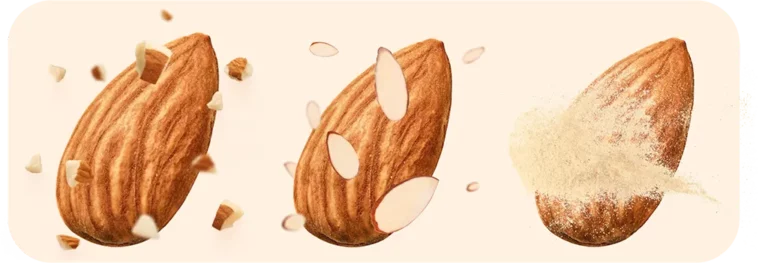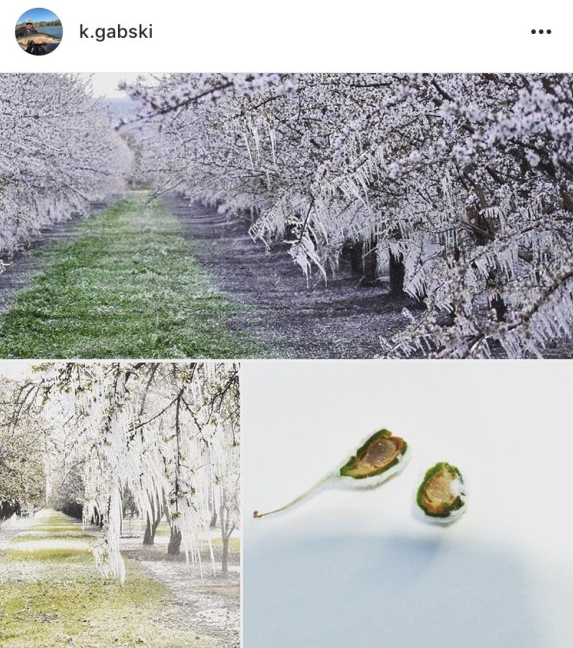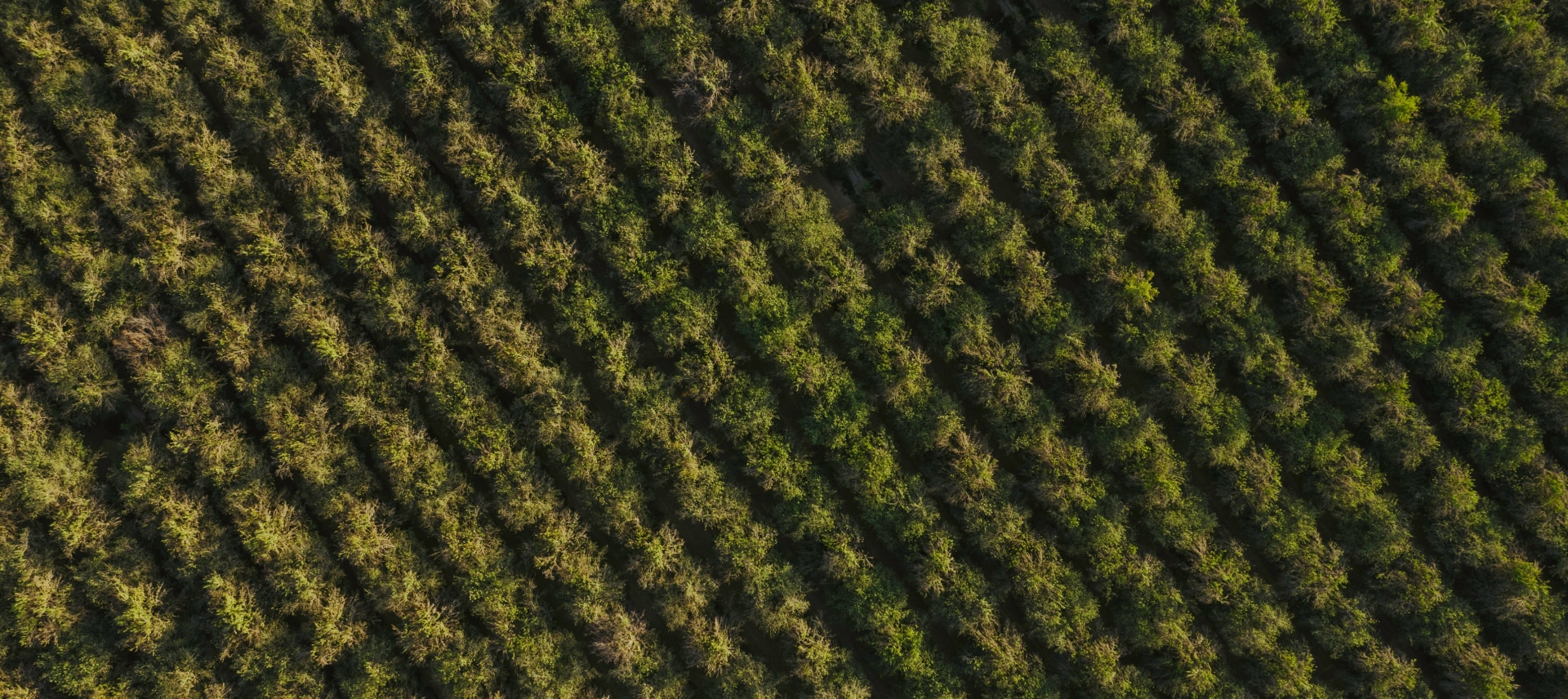Empty cart
Oh no! It appears your cart is empty. Add some almonds to your daily regime with the Treehouse products.
All Blog PostsNews
Early in the week of February 19th an unprecedented freeze hit the growing regions. Mother Nature had teased an early bloom from the trees with unusually warm weeks ahead of the frost. Consequently, the nonpareil and associated pollinator bloom was well underway, with the north uncharacteristically jumping out ahead of the south this year. We have heard reports of temperatures as low at 20 degrees in some areas, but reliably it is safe to say that for areas in the north 25 degrees and sometimes lower were recorded for extended periods of time. Here in our southern region we had orchards consistently in the 27 to 30 degree range for multiple nights. The arctic cold came in as a large air mass, not sparing the higher elevations and providing no chance for mixing of warmer air from above.
Blossoms and nutlets will become increasing susceptible to freeze with additional development. Textbook production charts inform that critical temperature at pink bud is 25 degrees, at full bloom it is 26 degrees and at nutlet stage it is 28 degrees and damage will occur if these temperatures are endured for 30 minutes or more. Running water through irrigation systems will help to elevate temps by 2 or 3 degrees, perhaps enough to save some orchards and not enough for others.

So, with orchards at various stages of development, with some growers able to apply irrigation and others not, we are expecting a patchwork of damage and much uncertainty as to the final outcome. We also are reminded every year by the resiliency of the almond tree to set a crop. Over the past twenty years it has been difficult to correlate adverse bloom weather with statewide production. For example in 2005 we set a terrible crop and 2011, another tough bloom, we set a record crop. With certainty, however we can say that crop will be below potential. In general we can expect more damage in the north and some of the east side higher elevations. Pundits are throwing around crop loss numbers in the 5% to 15% range. For reference, a potential crop of 2530 million (1.1 million acres x 2300 lbs per acre, for arguments sake) with 10% loss is now 2277 million – about unchanged from the last crop.
It is TOO EARLY to put a reliable number on it. On the optimistic side we know that the almond tree puts out 2 to 3 times as many flowers as it needs and reports citing damage to 70% of the flowers do not mean a corresponding loss of final production on the tree. We also know that weather prior to the freeze and over the past week has been conducive to pollination. The freeze aside, bloom has been strong with ample flowers and good overlap. The chilly nights and mornings have encouraged the bloom to linger. In the south we still see some viable nonpareil, while butte and padre definitely still definitely engaged. We can also point to a couple of quick moving storms that brought snowpack from 24% of average to more comfortable 50% of average and perhaps some more expected in the next week.
On the guarded side we note that this is the worst freeze at this time of year that even seasoned veterans can remember and certainly temperatures were in the ranges that produce crop loss.
We expect that growers will have a better idea as to the crop in specific orchards by the end of March. With the patchwork of losses out there piecing it all together into a well-reasoned state estimate is going to be very difficult task indeed.
Meanwhile, let’s get to what we can quantify in the numbers provided by today’s position report. Shipments continue to break records. This was somewhat to be expected given the strong commitments, but the February shipment number of 190.1 million lbs (up 24.9% versus last February’s 152.3 million) still managed to surprise. The contributions were once again broad based. Notably, Chinese shipments at 21.3 million (up 15.1 million versus a year ago), while Western Europe helped by strong Spanish and German imports totaled 59.8 million (up 14.2 million versus a year ago). Domestic shipments were up a workmanlike 3.8% or 2.0 million lbs at 53.8 million lbs.
Season to date shipments are now at 1422 million lbs, up 12.1% versus last season. As warned in last month’s report, shipment growth is not slowing down and the industry is heading into a difficult transition into new crop.
February receipt numbers provide no relief. An additional 7.9 million lbs were reported for the month, inching the 2017 crop total to 2251 million lbs. If the hullers were hiding it for later, we would have expected a bigger February total. For the sake of sold percentages and carry-over calculations we are now going to use a conservative 2270 million lbs for the final 2017 crop.
As might be anticipated given the paralysis in the market in the past several weeks, commitment numbers did drop by 75 million lbs to 524 million, inferring new sales of only 113 million lbs. The industry sold percentage of 87.5% of the 2017 crop (2270 less 2%) is still significantly higher than typical for this stage of the season. It now appears that the industry will have to draw down the carry-over. If shipments over the next 5 months slow down to an increase of just 3% (down from the current pace of 12.1%) the carry-over will shrink from 399 million lb at the start of the season to a numbingly tight 344 million lbs. Impossible of course to predict these numbers with certainty, but the point is that it is going to be a squeezer.
Heading into the freeze, we saw prices relatively steady with standard 5% near $2.50 per lb, Cal SSR 27/30’s near $2.60 and NPS 23/25 near $3.30 per lb. Since the freeze we have seen prices for most items increase by about 40 to 45 cents per lb as the market grappled with the impact. The increase has been most felt by the pollinators, with nonpareil (which was already enjoying a hefty premium) only adding about 25 cents per lb or so. In the past week we have seen prices pull back by about 5 cents as buyers have taken care of their immediate needs and sellers have started to emerge. Standards seem comfortable near $2.85 per, Cal SSR 27/30 are a little less discovered and ranging between $3.00 and $3.10 per lb, while NPS 23/25 seems to be finding a home near $3.60 per lb. Nonpareil inshell is bid at 2.65 per lb. Blanched sliced and slivered most recently were sold in the $3.65 to $3.75 per lb range.
The next move will depend on what additionally we learn about the 2018 crop over the next month or two. For now we know that shipments and demand is strong. At 12% shipment growth the market was seeming to anticipate and on track to consume a 2018 crop of 2500 million lbs. A 2500 million lb crop no longer appears to be in the cards and shipments have to slow. If we are on track for a crop of the same magnitude as last year every cent of the recent price jump is justified and perhaps there is more to come. All eyes on crop estimates over the next several months with the official Subjective and Objective estimates falling in early May and late June.
Regards,
Jonathan Meyer
CEO
Treehouse California Almonds, LLC.
Stay tuned for the release of significant almond industry information, such as almond crop estimates and acreage reports. You’ll also find Almond Board shipping reports and related analysis from the Treehouse Almonds Leadership Team.

Be in the loop for vital news about the California almond market.
Enjoy 10% off when you order 6 or more